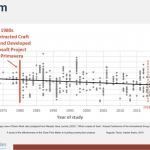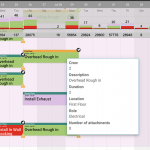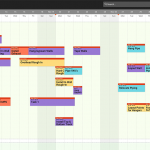(Hal Macomber, EVP, Touchplan with Adam Hoots, Operation Innovation, Langston) The Five Big Ideas Transforming Design and Construction were proposed in 2004 to a group of people in Northern California who were already embracing project-based production thinking. In 1999, the Lean Construction Institute published a few white papers on production theory as it applied to projects as did numerous researchers and academics in the International Group for Lean Construction (IGLC). Still, as people adopted phase pull planning from 2004 – 2007, production laws faded from the planning conversations. This is in spite of the near-ubiquitous use of the Parade of Trades® and the Lego® airplane production simulations in all Lean construction training. It wasn’t until I introduced This Is Lean, Resolving the Efficiency Paradox at the 2015 Lean Design and Construction Congress in Boston that production theory was back in the conversation. That simple theory consisted of three parts: 1) flow over resource efficiency, 2) visualization and 3) continuous improvement.
Three of the five big ideas are directly affected by the appropriate use of production thinking. They are “optimize the project as a whole,” “tightly couple learning with action,” and “conduct the project as networks of commitments”. The production theory issues are the same for all three. It has to do with Taiichi Ohno’s lesson,
Flow when you can; pull when you can’t.
Adam says, “Pursuing flow is paramount on projects! Projects must project purpose!” Whenever flow is broken all three of the above big ideas are impacted. Flow and pull break when production laws are not followed. Let’s start with the biggest villain, the blind practice of launching work on the master (critical path method) schedule per the planned start date. (In CPM-speak, pulling work to the data date.) This violates Little’s Law. In short, the more work we launch the further behind we get. When work-in-process rises without an appropriate increase in the workforce, then the overall duration increases.
The second large mistake we make is taking our eyes off the bottlenecks. A change anywhere in the process other than at the bottleneck will not improve the production rate. Letting the bottleneck move around only makes it worse! Find the bottleneck and then use them to pace the flow through that phase of work.
Third, uncontrolled variation makes the project a crapshoot. There are three important measures we use in the Last Planner System of Production Control® that directly relate to minimizing variation.
- Percent plan complete (PPC) — an improvement measure of the reliability of completing work items as promised (planned). Due to the compounding of variation with dependence, PPC must be greater than 70% to get timely milestone completion.
- Milestone completion — a key performance indicator for overall timely completion of the project.
- Making work ready — reliably addressing all of the roadblocks and constraints to starting and finishing work items as promised.
For all three metrics, the percent isn’t the interesting thing about the measures. It’s the difference between the metric and 100% that is interesting. In other words, learn from the delta. Understanding what is driving the variation allows us to focus on continuous improvement.
Adam notes, “CPM would work if we focused on flow.” That requires very quick feedback loops from what we set out to do and what happened. Without data-informed action, we get further off track. Adam says, “It’s the smallest details or misunderstandings in commitment keeping that takes us astray.” End of shift/day commitment management stand-ups among the last planners provides the “steering” to keep production flowing.
Whether we practice CPM Scheduling, Takt Planning, Last Planner System®, Pull Planning, or 3-week look-aheads, the point is that our teams must learn to focus on flow efficiency in lieu of resource efficiency. Once teams understand flow, the team will then be able to learn through visualization. Improvement of flow efficiency is what we all seek within our projects, sometimes WE just have a tough time verbalizing that. You’ll get the best outcomes when the five big ideas build on flow.
For more insights on Project Production Thinking you can read Data Driven Decisions Drive Better Project Management, or Takt Time Planning and Laws of Production: Getting the Most out of LPS.
If you would like to revisit any of the posts from the Revisiting the Five Big Ideas series you can find all of them below.
- Part 1: Transforming the Design and Construction Industry
- Part 2: Collaborate; Really Collaborate
- Part 3: Tightly Couple Learning with Action
- Part 4: Optimize the Project as a Whole
- Part 5: Conduct Construction Projects as a Network of Commitments
- Part 6: Bring an Outward Mindset to All Interactions
- Part 7: Project Production Thinking Behind the Five Big
- Part 8: Pursue Project Outcomes at the Intersection of the Five Big Ideas
- Part 9: Adopting the Five Big Ideas on Your CM/GC Projects
- Part 10: What Comes After The Five Big Ideas?










